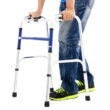How Assistive Medical Devices Like Canes and Walkers Affect Your Disability Benefits Case
April 2, 2023
If you have a condition that makes it necessary for you to use an assistive medical device like a cane, walker, wheelchair or other equipment, the Social Security Administration (SSA) will consider that need as they determine if you meet their definition of having a disability—as they decide on awarding you Social Security Disability benefits.
However, while the need for an assistive device for dexterity, stability, or mobility can enhance your disability case, it doesn’t automatically mean you will be approved for disability benefits.
Applying Social Security Disability rules to specific cases can get a bit complicated.
For example, in the Social Security’s Listing of Impairments (known as the “Blue Book”) to meet Listing 1.01 (impairments of the musculoskeletal system) one must have an “inability to ambulate [walk] effectively.”
If a claimant needs a walker or a cane in each hand in order to walk, typically that person will be found to be unable to ambulate effectively.
This is not really related to walking itself, but rather related to the need to use both hands to hold onto the canes or the walker. Because a single cane or a wheelchair does not require the use of both hands, Social Security says this does not result in an inability to ambulate.
Regardless of the type of device, for disability benefits consideration the SSA requires that you have a “documented medical need,” which means you must provide evidence supporting your medical need for an assistive device from an acceptable medical source.
For the purposes of assistive devices, the SSA considers licensed physicians (not chiropractors), nurse practitioners (ARPN, APN, NP, CNM, CRNA, CNS), and licensed podiatrists to be acceptable.
Establishing a documented medical need does not require a prescription, but it can be very helpful.
Absent a prescription, you should ask your doctor to provide medical evidence by acknowledging in writing (in a letter or with a notation in your medical records) the medical necessity of a non-prescribed medical device.
This medical evidence must describe any limitation(s) in your upper or lower extremity functioning, the circumstances for which you need to use the assistive device, and an acknowledgement that you will need the assistive device for continuous period of at least 12 months.
The SSA will consider both the type of assistive device that you use and the reason you need it in evaluating your claim for disability benefits.
Often we see disability applicants who are using assistive devices (especially canes and walkers) they bought at a pharmacy or borrowed from a friend of family member.
Because these are “self-prescribed” devices, the Social Security administrative law judge may not be convinced you need an assistive device and may determine that they are not medically necessary.
This is why it is so important for your medical professional to document not only that you require an assistive device, but why. It’s also important to document if it is needed for standing, walking or both.
Let your disability benefits attorney know that you are using an assistive device so he or she can effectively present your case.
And if you don’t have legal representation, we invite you to contact us at Nash Disability Law for an evaluation of your case—for free with no strings and no obligation.
If you choose to work with our disability law firm, we only get paid if you win your disability case and qualify to begin receiving benefits.


